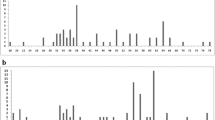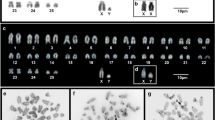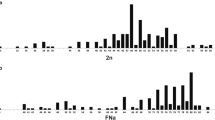Abstract
The karotypes of eleven species of the South American burrowing rodents, genus Ctenomys are described, and information on the somatic number of two other species of the same genus is given. The studied species are: C. torquatus (2n ♂=68), C. tuconax (2n ♂=61), C. minutus (2n=50), C. talarum (2n= 48), C. porteousi (2n=48), C. cf. minutus (2n=48), C. australis (2n=46), C. azarae (2n=48), C. latro (2n=42), C. magellanicus fueguinus (2n=36), C. tucumanus (2n=28), C. opimus luteolus (2n=26), and C. occultus (2n ♀=22). This extreme intrageneric variation in somatic number is also reflected by a great amount of diversity in chromosome structure. Karyotypes seem to be rather constant at the species level. Autosomal polymorphism has been found in two of the species, namely C. talarum and C. latro. The hypothesis of the superimposition of Robertsoman rearrangements, pericentric inversions and translocations in the evolution of the karyotype of Ctenomys is advanced. The direction of chromosome change, either toward increase or decrease in chromosome number, is discussed. It is emphasized that high chromosome multiformity is correlated in Ctenomys with a rapid and explosive pattern of species diversification; the meaning of the small size of populations in enhancing the role of chromosome rearrangements in the evolution of Ctenomys is discussed.
Similar content being viewed by others
References
Bender, M. A., Chu, E. H. Y.: The chromosomes of primates. In: Evolutionary and genetic biology of the primates (J. Buettner-Janesch, ed.), vol. 1, p. 261–310. New York: Academic Press 1964.
Cabrera, A.: Catálogo de los Mamiferos de América del Sur. Rev. Mus. Arg. C. Nat. “B. Rivadavia”. (Zool.) 4, 1–732 (1957–60).
Chu, E. H. Y., Swomley, B. A.: Chromosomes of lemurine lemurs. Science 133, 1925–1926 (1961).
Contreras, J. R., Reig, O. A.: Datos sobre la distribución de género Ctenomys (Rodentia, Octodontidae) en la zona costera de la Provincia de Buenos Aires comprendida entre Necochea y Bahia Blanca. Physis 25, 169–186 (1965).
Court Brown, W. M.: Human population cytogenetics. Amsterdam: North-Holland Publ. Co. 1967.
Ellerman, J. R.: The families and genera of living rodents. Vol. I. Rodents other than Muridae. Brit. Mus. (Natural History) London i–xxvi, 1–689 1940.
Evans, E. P., Lyon, M. F. Daglish, M.: A mouse translocation giving a metacentric marker chromosome. Cytogenetics 6, 105–119 (1967).
Fernandez Donoso, R.: Identification and behaviour of the sex bivalent in male Octodon degus. M. Biologica (Santiago) 38, 30–37 (1966).
Ford, C. E., Hamerton, J. C., Sharman, G. B.: Chromosome polymorphism in the common shrew. Nature (Lond.) 180, 392–393 (1957).
—, Hamerton, J. L.: A colchicine, hypotonic citrate sequence for mammalian chromosomes. Stain Technol. 31, 247–251 (1956).
Gorman, G. C., Atkins, L., Holzinger, T.: New karyotpyic data on 15 genera of lizards in the family Iguanidae, with a discussion of taxonomic and cytological implications. Cytogenetics 6, 286–299 (1967).
Hall, W. P.: Non-geographic speciation. Models for chromosomal speciation, MS. Museum of Comp. Zool. Harvard University (1969).
Hamerton, J. L.: Problems in mammalian Cytotoxanomy. Proc. Linn. Soc. Lond. 169, 112–124 (1957).
—: Primate chromosomes. Symp. Zool. Soc. Lond. 10, 211–219 (1963).
Howard, W. E.: A live trap for pocket gophers. J. Mammal. 33, 61–65 (1952).
Hsu, T. C., Arrighi, F. E.: Chromosomal evolution the genus Peromyscus (Cricetidae, Rodentia). Cytogenetics 5, 355–359 (1966).
John, B., Hewitt, G. M.: Patterns and pathways of chromosome evolution within the Orthoptera. Chromosoma (Berl.) 25, 40–74 (1968).
—, Lewis, K. R.: The chromosome complement, in Protoplasmatologia VI/A. 206 Wien and New York: Springer 1968.
Kiblisky, P., Reig, O. A.: Variation in chromosome number within the genus Ctenomys and description of the male karyotype of Ctenomys talarum talarum Thomas. Nature (Lond.) 212, 436–438 (1966).
Levan, A., Fregda, K., Sandberg, A. A.: Nomenclature for centromeric position on chromosomes. Hereditas (Lond.) 52, 201–220 (1964).
Lima-de-Faria, A.: The role of the kinetochere in chromosome organization. Hereditas (Lund) 42, 85–160 (1956).
Matthey, R.: L'évolution de la formule chromosomiale chez les vertébrés. Experientia (Basel) 1, 50–56, 78–86 (1945).
—: Polymorphisme chromosomique intraspécifique chez un Mammifére Leggada minutoides Smith (Rodentia, Muridae). Rev. Suisse Zool. 70, 173–190 (1963).
—: La signification des mutations chromosomiques dans les processus de spéciation. Etude cytogénétique du sous-genre Leggada Gray (Mammalia, Muridae). Arch. Biol. 75, 169–206 (1964).
—: Cytogénétique et taxonomie des rats appartenant au sous-genre Mastomys Thomas (Rodentia, Muridae). Mammalia 30, 105–119 (1966a).
—: Une inversion péricentrique à l'origine d'un polymorphisme chromosomique non-Robertsonien dans une population de Mastomys (Rodentia, Muridae). Chromosoma (Berl.) 18, 188–200 (1966b).
Nadler, C. F.: Chromosomes and systematics of American ground squirrels of the subgenus Spermophilus. J. Mammal. 47, 4 579–596 (1966).
—, Block, M. H.: The chromosomes of some North American chipmunks (Sciuridae) belonging to the genera Tamias and Eutamias. Chromosoma (Berl.) 13, 1–15 (1962).
Nevo, E.: Mole rat Spalax ehrenbergi: mating behavior and its evolutionary significance. Science 163, 484–486 (1969).
Osgood, W. H.: The mammals of Chile. Zool. Series, Field Mus. Nat. Hist. 30, 1–268 (1943).
Pascual, R., Pisano, J., Ortega, E. J.: Un nuevo Octodontidae (Rodentia, Caviomorpha) de la formación Epecuen (Plioceno Medio) de Hidalgo (Provincia de La Pampa). Consideraciones sobre los Ctenomyinae Reig. 1958 y la morfologia de sus molariformes. Ameghiniana 4, 19–30 (1965).
Patton, J. L., Dingman, R. E.: Chromosome studies of pocket gophers, genus Thomomys. I. The specific status of Thomomys umbrinus (Richardson) in Arizona. J. Mammal. 49, 1–13 (1963).
Reig, O. A.: M. S. Correlación positiva entre la tasa de cambio cromosómice y la tasa de evolución taxonómica en los mamiferos. IV Congr. Latinoameric. de Zool. Caracas 10–16 de Nov. 1968.
- Ecological notes on the fossorial octodont rodent Spalacopus cyanus (Molina), with a discussion of the probable bearing of different ways of life on the evolution of Ctenomys and Spalocopus. J. Mammal. (in press, 1969).
—, Contreras, J. R., Piantanida, M. J.: Contribución a la elucidación de la sistemática de las entidades del génere Ctenomys. Contribuciones Cient. Fac. C. Exactas y Nat. Univ. de Buenos Aires (Zool.) 2, 6, 297–352 (1966).
—, Kiblisky, P.: Chromosomes in four species of Rodents of the tenus Ctenomys (Rodentia, Octodontidae) from Argentina. Experientia (Basel) 24, 274–276 (1968).
Roig, V., Reig, O. A.: Precipitin test relationships among Argentinian species of the genus Ctenomys (Rodentia, Octodontidae). Comp. Biochem. Physiol. 30, 665–672 (1969).
Pearson, O. P.: Biology of the subterranean rodents, Ctenomys. Peru. Mem. Mus. Hist. Nat. “Javier Prado” 9, 1–56 (1960).
Rusconi, C.: Dispersión geográfica de los tuco-tucos vivientes (Ctenomys) en la Región Neotropical. Anales Soc. Argentina Estudios Geograf. “GAEA”. 3, 235–250 (1928).
— Las especies fósiles del género Ctenomys con descripción de nuevas especies. Anales Soc. Cient. Arg. 122, 129–164 (1931).
Soldatović, B, Żivković, S., Savić, J., Milosević, M.: Vergleichende Analyse der Morphologie und der Anzahl der Chromosomen zwischen verschiedenen Populationen von Spalax leucodon Nordmann, 1840. Z. Säugetierk. 32, 238–245 (1967).
Sparkes, R. S., Arakaki, D. T.: Intrasubspecific and intersubspecific chromosomal polymorphism in Peromyscus maniculatus (deer mouse). Cytogenetics 5, 411–418 (1966).
Tate, C. H. H.: The taxonomy of the genera of neotropical hystricoid rodents. Bull. Amer. Mus. Nat. Hist. 68, 295–447 (1935).
Thaeler, C. S., Jr.: Karyotype of sixteen populations of the Thomomys talpoides complex of pocket gophers (Rodentia, Geomyidae). Chromosoma (Berlin) 25, 172–183 (1968).
Thomas, O.: Description of new rodents from Western South America. Ann. Mag. Nat. Hist. 6, 383–387 (1900).
Tobias, P. V.: Trends in the evolution of Mammalian Chromosomes. S. Afr. J. Sci. 50, 134–140 (1953).
—: Chromosomes, sex-cells, and evolution of a mammal. London: Percy Lund, Hemphries and Co. Ltd. 1956, 420 p.
Todd, N. B.: A theory of karyotypic fissioning, genetic potentiation and eutherian evolution. Mamm. Chromosome Newsletter 8, 268–279 (1967).
Wahrman, J., Goitein, R., Nevo, E.: Mole rat Spalax evolutionary significance of Chromosome variation. Science 164, 82–84 (1969).
—, Zahavi, A.: Cytological contributions to the phylogeny and classification of the rodent genus Gerbillus. Nature (Lond.) 175, 600–602 (1955).
White, M. J. D.: Some general problems of chromosomal evolution and speciation in animals. Surv. Biol. Progr. 3, 109–147 (1958).
— Speciation in animals. Aust. J. Sci. 22, 32–39 (1959).
Wright, S.: On the probability of fixation of reciprocal translocations. Amer. Naturalist 75, 513–522 (1941).
Author information
Authors and Affiliations
Rights and permissions
About this article
Cite this article
Reig, O.A., Kiblisky, P. Chromosome multiformity in the genus Ctenomys (Rodentia, Octodontidae) . Chromosoma 28, 211–244 (1969). https://doi.org/10.1007/BF00331531
Received:
Accepted:
Issue Date:
DOI: https://doi.org/10.1007/BF00331531




